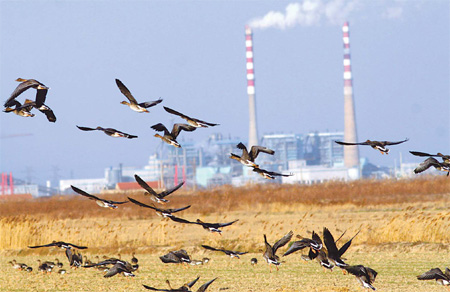Society
Birds still flocking to Yangtze wetlands
Updated: 2011-03-03 07:53
By Chen Liang (China Daily)
|
Wintering bean geese gather on a reed field near Yancheng National Nature Reserve in Jiangsu province. Chen Liang / China Daily |
|
Wang Hui records his sightings at Yancheng National Nature Reserve. Chen Liang / China Daily |
Initial results from the third survey of the country's waterbird population in the Yangtze flood plains look positive, Chen Liang discovers.
The flood plains in the lower reaches of the Yangtze River, which stretch through Hubei, Hunan, Jiangxi, Anhui, and Jiangsu to Shanghai, are one of China's richest wetlands in terms of natural resources and waterbirds. In 2004, World Wildlife Fund (WWF) China Program and the State Forestry Administration launched the first comprehensive count of waterbirds in this region, to assess the deterioration of the wetlands, and followed this up with another in 2005.
They showed that farming, over-fishing and rapid development in lake areas were destroying the habitats of the birds, and affecting their food chain.
This year's count of waterbirds on the lower Yangtze River flood plain, that began in mid-January - when their numbers peak - remained incomplete until the second week of February, due to the Spring Festival break.
The count in Anhui was affected "by an earthquake in one of the survey areas and bad weather", says Lei Gang, head of Central Yangtze of the WWF China Program and coordinator of the project.
"(But) the populations of waterfowl are relatively stable in their wintering grounds when there is no significant human interference and interference is usually minimal during the holidays," he says in a telephone interview with China Daily. "So we think the delay won't have much influence on the results of our count."
The survey is aimed at providing valuable data on the populations of waterfowl, and their distribution and habitats, so meaningful comparisons can be made with results from the previous two surveys.
It will help the authorities obtain a clearer view of the status of waterbirds in the region, address major threats to them, and improve effective protection of the birds as well as the management of their habitats.
"With unprecedented levels of snow and freezing rain in the southern part of the country in early 2008, we want to know whether that disaster had any profound impact on the populations and distribution of wintering waterbirds," Lei says.
He and his colleagues are still waiting for figures from the teams in Anhui, Jiangxi and Shanghai. But initial results look positive, he says.
So far, 178,000 waterbirds have been recorded in Hunan and more than 68,000 in Hubei, Lei says. In 2004 and 2005, the figures were about 110,000 in Hunan and 50,000 in Hubei.
The conservationist also says that while they found large congregations of tundra swan only at Shengjin Lake in Anhui province and Boyang Lake in Jiangxi province in 2004 and 2005, good numbers of the bird have been seen in a few lakes of Hubei and Hunan this year.
The bird, together with the swan goose, is known to "be very picky about food" - their diet consists mainly of a particular kind of aquatic vegetation, which requires a good environment to grow.
"So it probably means an improvement in the water quality in more lakes in the region because of better protection in the past few years," Lei says.
Specials

NPC & CPPCC sessions
Lawmakers and political advisers gather in Beijing to discuss major issues.

Self-made aircraft
An automobile mechanic in Northeast China made a test flight of his self-made aircraft which cost about US$395.

Venetian Carnival
Masked revellers celebrate in Saint Mark's Square in Venice.

